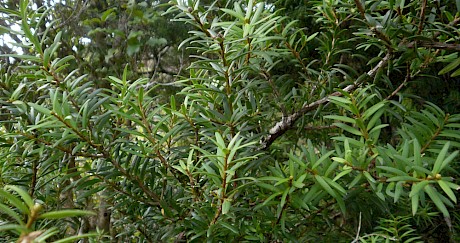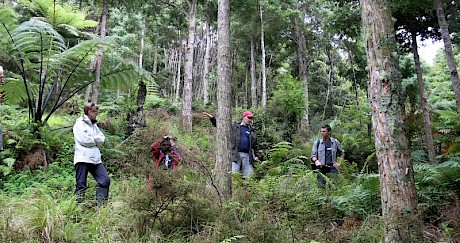Kaikawaka (Libocedrus bidwillii)
History
Kaikawaka appears to have been little used by the Maori (who also know it as pahautea) although its light weight made it useful in the construction of backpacks used to carry heavy loads like stone. It was found useful by early European settlers because it was originally supposed to be quite durable and, like totara, was used for fence posts, house blocks, roof shakes and weather boards. Unfortunately later tests proved it to be of only moderate durability.
Distribution
The species is found from latitude 36° 50’ (Mt Moehau) south, but not in Fiordland or on Stewart Island. Generally regarded as montane species, it grows between 450 and 1200 metres altitude in the North Island and in the South Island between 300 and 1200 metres. The main concentrations of the species are the mountains of Nelson, Westland, the Catlins, Tongariro National Park and the Ruahine Ranges. Its northern counterpart, Libocedrus plumosa (kawaka) is generally much less common and grows from the Far North south to NW Nelson; so overlapping L. bidwillii.
Tree size and growth
Not a large forest tree, kaikawaka grows to about 20 metres tall and one metre in diameter, but more usually 30 – 60 cm. Kawaka is slightly larger – to 25 metres tall and 1.2 metres diameter. The largest recorded tree is in South Westland and is 20 metres tall and 125 cm in diameter. Little information is available of growth rates, the only information found giving an average height growth rate of 16 cm (max 25 cm) annually with diameter at 3.1 mm. Trials with kawaka in the Hunua Ranges show its growth rate to be faster; up to 46 cm height growth and 6.2 mm diameter growth per annum for 15 year old trees.
Timber
Timber characteristics, with P radiata figures shown in brackets for comparison, are as follows: -
Density (green) 977 kg/ m³ (930 kg m³)
* (dry) 415 kg/ m³ (500 kg/m³ )
Tangential shrinkage -green to 12% m.c 4.5 % (4.7%)
Radial shrinkage 1.8 % (2.2%)
Modulus of rupture 43 Mpa (90 Mpa)
Modulus of elasticity 5.1 Gpa (9 Gpa)
A dry density of 415 makes kaikawaka the lightest native timber species. It is however slightly heavier than Thuja plicata (370 kg/ m³) and Sequoia sempervirens (380 kg/ m³)
It is also a very soft and brittle wood. The heartwood is reddish brown and the sap yellow to pinkish white. While the sapwood is not durable it is resistant to the common house borer. An interesting and useful characteristic of the timber is that it is fire-resistant.
Potential
As the lightest New Zealand timber, kaikawaka may have uses where lightness and moderate durability are desirable attributes. One major potential is for roof shingles, given that the timber splits easily, is light and relatively fireproof. An important non timber use might be as a foliage and tub plant.
Research requirements
Knowledge of the growth rate and ecological requirements of kaikawaka appear to be poorly understood and need to be investigated before it can be grown as a possible timber tree.
Refereneces
- Allan H H 1961. Flora of New Zealand Vol. 1 Government Printer Wellington
- Burstal S W & Sale E V 1984. Great Trees of New Zealand
- Clifton N C 1990. New Zealand timbers
- Hinds H V & Reid J S 1957. Forest Trees and Timbers of New Zealand. Govt Printer Wellington
- Pardy G F, Bergin D O & Kimberley M O 1992. Survey of Native tree plantations. FRI Bulletin 175
- Wardle J 2007. Mountian cedar (Libocedrus bidwillii) pahautea. Indigena Feb 2007. 26 - 28
Species profile by Ian Barton


